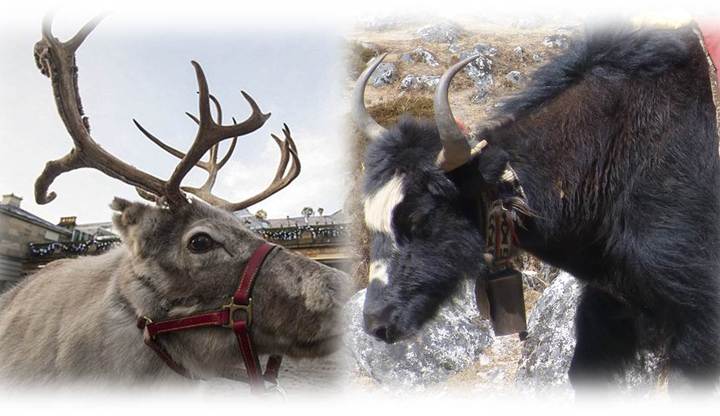Reindeer VS Yak - The Christmas Battle
It’s long been known that Father Christmas has favoured the loveable reindeer to help him deliver presents to all the children around the world, but having witnessed the power of the might Nepalese Yak, is Father Christmas and the elves missing a trick?
Back in 1823, an American fellow called Clement Clarke Moore penned A Visit from Saint Nicholas (aka The Night Before Christmas), a tale of six reindeers named Dasher, Dancer, Prancer, Vixen, Comet, Cupid, Dunder and Blixem (the last two of which were later changed from Dutch to German, becoming Donner and Blitzen). This is the first known reference to reindeers and Christmas. Prior to this it’s not known how Father Christmas achieved this yearly feat, one can only assume that he had access to an early version of Amazon Prime.
Rudolph was not introduced to us until 116 years later in 1939, when Robert L. May’s children’s book told us the story of Rudolph the Red-Nosed Reindeer, he the one with his nose so bright who has helped lead the way in the dark ever since.
Yak’s however have graced the earth for much longer. With fossil remains of both the domestic and its wild ancestor being found that date back to the Pleistocene period, which was around 2,588,000 to 11,700 years ago. In the last 10,000 years or so the humble yak has spread itself out across roughly 2.5 million square meters on the Roof of the World or the Qinghai-Tibetan Plateau. Further to this they have also spread northwards and southwards (albeit in smaller numbers) and can now commonly be found at elevations between 2,000 and 5,000 meters.
With these facts in mind, should Father Christmas be reconsidering his long standing commitment to Rudolph and friends or should he be looking further afield to their mountain cousins?
We weigh these two beasts up against each other to decide once and for all who the ultimate Christmas warrior is.
Full Name
REINDEER
Rangifer tarandus
YAK
Bos grunniens
Related To
REINDEER
Reindeer and caribou both belong to the Rangifer genus and are therefore related to deer
YAK
Yaks belong to the genus Bos, and are therefore related to cattle
Country of Origin
REINDEER
They are native to Arctic, Subarctic, tundra, boreal and mountainous regions of northern Europe, Siberia, and North America
YAK
They are found throughout the Himalaya region of southern Central Asia, the Tibetan Plateau and as far north as Mongolia and Russia
Weight
REINDEER
- Females - 80-120 kg (180-260 lb)
- Males - 159-182 kg (351-401 lb)
YAK
- Female - 225 to 255 kg (496 to 562 lb)
- Male - 350 to 580 kg (770 to 1,280 lb)
Height
REINDEER
- Females - 162-205 cm (64-81 in)
- Males - 180-214 cm (71-84 in)
YAK
- Male - 2.5 to 3.3 m (8.2 to 11 ft) - females are around 30% smaller
Distinguishing Features
REINDEER
They have two layers of fur - a thick woolly undercoat and a longer-haired overcoat which consists of hollow, air-filled hairs which helps to keep the reindeer warm.
YAK
They are insulated by dense, close, matted under-hair as well as their shaggy outer hair. Yaks secrete a special sticky substance in their sweat which helps keep their under-hair matted and acts as extra insulation.
Top Speed
REINDEER
80km/h (50mph)
YAK
40km/h (25mph)
Weight they can pull
REINDEER
Up to 40kg
YAK
Up to 60 - 80kg
Special Skills
REINDEER
Reindeer's hooves can adapt to the season. In summer when the ground is soft and wet, their footpads become sponge like in order to get a bigger surface area to help them stay steady. In winter they shrink and tighten which exposes the rim of the hoof allowing them to cut into ice and crushed snow which helps to stop them slipping.
YAK
Nothing on a yak will go to waste! Their meat is eaten and their milk is used in cooking and for tea. Yak's dung is used to produce fuel for the community and their wool is used for clothing, blankets etc.
Flying is the one main skill both animals need to have, but as there is no proven scientific evidence on how the reindeer's achieve this each year, we can only put this down to good old fashioned Christmas magic from the North Pole. As we all know there is an abundance of this down there so fears of yaks not flying can be put aside. Don't forget if Dorothy can make a moose head mounted on a sofa with fern wings fly in Return to Oz, I'm pretty sure Jolly St Nick will have the Yak's covered too.
So who is the better beast? If we are looking at pure pulling power and weight lifting our hairy yak's beat the dainty reindeer hands down. But when it comes to who is more friendly and is less likely to cause an accident (as the team know well you never cross paths with a yak) the gentle reindeer would ensure that no child was harmed should they encounter Father Christmas and his crew on Christmas Eve.
All in all both have their strengths and weaknesses and here at Xtreme Everest we have a special fondness in our hearts for the yak so we're not willing to write them off. Perhaps Lapland should have a few yaks on standby just in case the reindeer's have one too many carrots the night before.
So wherever you are, be it tucked up in bed in the countryside or city or perched upon Mount Everest, rest assured one of our animal friends will make it to you on Christmas Eve.
He sprang to his sleigh, to his team gave a whistle,
And away they all flew like the down of a thistle.
But I heard him exclaim, ‘ere he drove out of sight,
"Happy Christmas to all, and to all a good-night!"
Share this :





